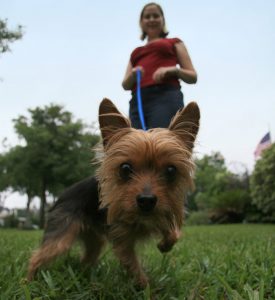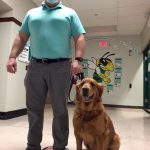How to Stop Leash Aggression According to Experts and Real Dog Owners
March 24, 2020

It’s never more apparent dogs are related to wolves than when they snarl, bare their teeth and get into attack mode. Scary, much? Big time. Especially when it happens during a walk with other people—including children—and pets around. Leash aggression in dogs is problematic behavior that can result in your pup harming herself or others. Here’s how to stop leash aggression so you can get back to enjoying those leisurely walks.
What counts as leash aggression?
Sometimes referred to as leash reactivity, leash aggression is intense behavior escalated by wearing a leash. Simple enough, right? Since leashes and walks go hand-in-hand, this nasty behavior will often come out on your daily strolls.
General aggression can look like barking, growling, lunging, pulling and generally trying to run after other dogs or people. Leash aggression is different in that it only happens while your pup is on a leash. Some dogs are perfect angels who cuddle and obey at home but turn into little monsters once you click that leash on.
What causes leash aggression?
As with most behavioral conditions, it’s often hard to pinpoint a specific cause or onset. Aggression itself can stem from anger, fear or frustration. For dogs, aggression may manifest after a single incident or not until she’s experienced dozens of similar incidents. However, the following issues frequently cause leash aggression:
- Poor socialization: Socializing puppies is super important because it teaches them how to play well with others, feel confident instead of anxious and engage safely in activities like vet visits, vacations and more. Basically, socialization is the most important thing you can do for a new puppy. Without these skills, adult dogs tend to be much more aggressive.
- Loneliness: If your pup is home along all day, an evening walk may be the only time she feels she’s getting attention from you. This could cause her to lash out at other dogs she sees.
- Fear: According to VCA Ark Animal Hospitals, dogs who are afraid of other animals may feel trapped by their leashes. Since they can’t retreat, they’ll get aggressive.
- Bad experience: Any dog who’s had a negative experience with a leash or while on a leash could begin to snarl or bark when tethered to one.
- Ineffective training: Aside from socialization, dog parents must train their pups to walk. This sounds silly, but it’s true! Dogs who aren’t provided structure or rules for walks may freak out when presented with new stimuli on a stroll.
- Freedom: It’s possible that a dog given free range of a large yard all day could see a leashed walk as a punishment of some kind. This could lead to aggressive behavior.
How to stop leash aggression
So, what is to be done? First and foremost, you’ve got to pay a visit to your vet. Dogs can have underlying medical conditions that either trigger aggression or cause discomfort, which then leads to aggression.
Second, it’s imperative you focus on positive reinforcement of good behaviors. This means don’t punish your dog when she does something bad, but do reward her when she does something you want her to keep doing.
Also, stay calm during training and walking. Even if your dog gets riled up, remaining calm will signal to her that there is no real threat.
If your pup only exhibits scary behavior while leashed, The American Kennel Club advises removing the walk factor for a while. Simply sit outside with your dog (leashed!) in an area where you’re likely to see at least a few other canines. Bring some treats with you (preferably special ones she doesn’t typically get). The goal at first is to teach your pup to focus on you rather than other dogs. As soon as she notices another dog, offer her the treat. Even if she doesn’t react aggressively to the other dog, continue to give her treats. Shift her focus from them, to you. Get in a few reps on each walk and repeat for several weeks, until she instinctively checks in with you if another dog approaches. Then, add the actual walking part back in, maintaining this practice to continue the behavior.
If starting out in a public space seems impossible, begin this process at home. Along with treats, teach your dog to look at you when you make a specific command or sound. This can take a few weeks, too. The goal here is getting your dog’s attention in any environment, without calling her name.
The Humane Society reminds us dogs greet each other by sniffing genitals. That’s just the way it is! On walks, when two dogs approach each other face to face, this standard greeting is replaced by a much more aggressive one: advancing head on. If possible, alter the route to arc around an oncoming dog to decrease the intensity of this approach. Or, simply turn around and head back the other direction.
Every dog will respond differently to tactics. Some will work better than others. In fact, as Debra Horwitz, DVM, DACVB, and Gary Lansberg, DVM, DACVB, outlined in an article for VCA Ark, even taking a soothing tone when trying to calm your dog could be detrimental. This sounds like praise and she could see it as a good thing when she lashes out. On the other hand, loud yelling, shouting “No,” or using prong collars to control behavior tends to stress out canines even more and will likely increase aggression.


 When Luke Hengen’s diabetes worsened in his early twenties, it stripped him of the outdoor activities where the country kid felt at home. Countless wilderness adventures and years of hard-fought football games took a toll on his body, to the point where he could no longer sense when his blood sugar was too high or […]
When Luke Hengen’s diabetes worsened in his early twenties, it stripped him of the outdoor activities where the country kid felt at home. Countless wilderness adventures and years of hard-fought football games took a toll on his body, to the point where he could no longer sense when his blood sugar was too high or […] When middle school students return to class on Jan. 11, they’ll find a new face at the door: Daisy. Daisy is a therapy dog and the personal pet of Rob Kreger, principal of the Rock L. Butler Middle School. The five-year-old golden retriever is not a school pet or mascot, but rather a working dog […]
When middle school students return to class on Jan. 11, they’ll find a new face at the door: Daisy. Daisy is a therapy dog and the personal pet of Rob Kreger, principal of the Rock L. Butler Middle School. The five-year-old golden retriever is not a school pet or mascot, but rather a working dog […] Last March, Caroline Benzel, a third-year medical student, began to notice the stress and discomfort her nurse friends were feeling from the pressures of the ongoing Covid-19 pandemic. “[Personal protective equipment] can be really rough on the skin,” Benzel, 31, tells PEOPLE. Benzel and her 3-year-old Rottweiler, Loki (who’s also a therapy dog) hatched a […]
Last March, Caroline Benzel, a third-year medical student, began to notice the stress and discomfort her nurse friends were feeling from the pressures of the ongoing Covid-19 pandemic. “[Personal protective equipment] can be really rough on the skin,” Benzel, 31, tells PEOPLE. Benzel and her 3-year-old Rottweiler, Loki (who’s also a therapy dog) hatched a […] When Stanley the miniature fox terrier’s owner passed away, the little dog started a ‘paw-some’ new role – bringing puppy love to some of the Gold Coast’s oldest residents. After Carinity Cedarbrook Diversional Therapist Julianne Staff adopted Stanley, he began visiting the aged care community at Mudgeeraba as a therapy dog. Therapy dogs help to […]
When Stanley the miniature fox terrier’s owner passed away, the little dog started a ‘paw-some’ new role – bringing puppy love to some of the Gold Coast’s oldest residents. After Carinity Cedarbrook Diversional Therapist Julianne Staff adopted Stanley, he began visiting the aged care community at Mudgeeraba as a therapy dog. Therapy dogs help to […] A nonprofit is providing an unusual form of therapy for those on the front lines of the coronavirus pandemic – puppy cams! “You spend five minutes with a puppy and try not to smile,” said registered nurse Robin Lingg Lagrone. Lingg Lagrone says watching little furballs wag their tails and prance on their paws helps […]
A nonprofit is providing an unusual form of therapy for those on the front lines of the coronavirus pandemic – puppy cams! “You spend five minutes with a puppy and try not to smile,” said registered nurse Robin Lingg Lagrone. Lingg Lagrone says watching little furballs wag their tails and prance on their paws helps […] When Moore County’s school doors were abruptly closed earlier in 2020, two- and four-legged volunteers from the Moore County Citizens’ Pet Responsibility Committee (PRC) were in their 12th year of presenting a six-session Pet Responsibility Education Program for fourth-graders. The PRC quickly shifted gears and placed its program materials online as part of a home […]
When Moore County’s school doors were abruptly closed earlier in 2020, two- and four-legged volunteers from the Moore County Citizens’ Pet Responsibility Committee (PRC) were in their 12th year of presenting a six-session Pet Responsibility Education Program for fourth-graders. The PRC quickly shifted gears and placed its program materials online as part of a home […]